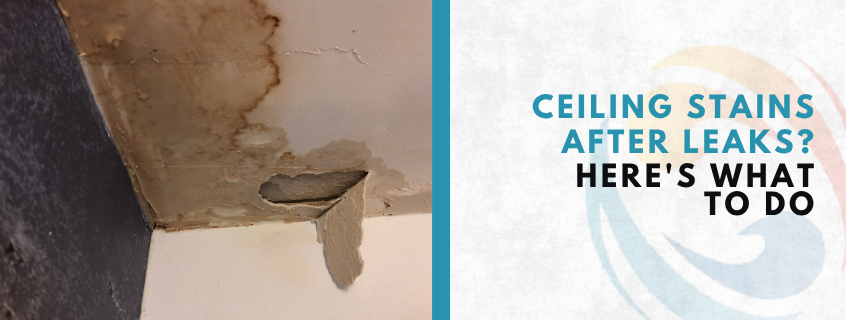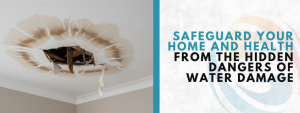
It all started with a little brown spot on the ceiling above the living room couch. At first, it looked like a shadow. Then, as the days passed, that shadow turned darker. A faint yellow ring formed around it. That’s when it hit—there was a leak above. And that unsightly blemish? It was one of many ceiling stains caused by water damage.
If you’ve ever been in this situation, you’re not alone. Ceiling stains are surprisingly common after a water leak. But don’t ignore them. These stains are more than just ugly—they’re clues. Clues that something bigger might be lurking just above your ceiling.
Let’s walk through what you should know, what to look for, and most importantly, what to do next.
What Causes Ceiling Stains After a Leak?
Ceiling stains can come from more than just a dripping roof. Think of your ceiling as a sponge. Once water leaks through—whether from a broken pipe, heavy rain, or a bathroom overflow—it gets absorbed and leaves behind discoloration.
The most common causes of ceiling stains include:
- Leaky Roof: Cracked shingles or broken tiles let rain seep in.
- Faulty Plumbing: Pipes running through ceilings may drip when joints loosen or freeze.
- HVAC Condensation: Air conditioning units in attics can create excess moisture.
- Overflowing Tubs or Toilets: Water finds its way down through the flooring and into the ceiling.
- Damaged Seals: Around skylights or chimneys, where water can sneak in.
Each of these creates one shared outcome—ceiling stains that tell a bigger story.
How to Identify the Severity of the Ceiling Stains
Not all stains are equal. Some are harmless surface issues. Others? A warning sign of major water damage or even mold growth.
To figure out what you’re dealing with, look closely:
- Color of the Stain:
- Light yellow or brown: Usually from old leaks or minor damage.
- Dark brown, black, or greenish: This may suggest mold or more serious water issues.
- Shape and Size:
- Small round stains often indicate a slow, ongoing leak.
- Spreading stains or patterns may point to a broken pipe or a large spill.
- Texture:
- Soft or sagging ceiling: Water is still present. Act quickly.
- Cracks forming: The ceiling may collapse if the issue isn’t handled.
Here’s a quick table to help you evaluate ceiling stains:
| Stain Color | Likely Cause | Action Needed |
| Yellow ring | Minor leak dried up | Monitor, paint over if dry |
| Brown patch | Aging roof or pipe leak | Inspect above area |
| Black/Green | Mold or long-standing water | Professional removal |
| Flaky paint | Prolonged dampness | Dry out & repaint |
First Steps When You Spot a Ceiling Stain
Discovering ceiling stains isn’t the end of the world, but it is a sign to act. Quickly.
Here’s what to do the moment you see it:
- Take a photo of the stain for documentation.
- Touch around the spot gently to check for dampness.
- Turn off the electricity in that section if moisture is present.
- Locate the source of the leak if it’s visible (e.g., roof, upstairs bathroom).
- Contain the damage by placing a bucket or towel underneath.
- Avoid poking holes unless you’re sure water is pooling above.
You don’t want to just clean the stain—you want to stop the leak first. Once water stops coming in, you can start thinking about repair and cleanup.
And if you’re unsure where the water’s coming from, don’t risk it. It’s safer and faster to let professionals handle the diagnosis. You can explore trusted help through this water damage restoration service that specializes in situations just like this.
Can Ceiling Stains Lead to Mold?
Unfortunately, yes. Mold loves damp, dark places. When water gets trapped in your ceiling, it creates the perfect environment for mold to grow.
Even a small ceiling stain can mean there’s hidden moisture, especially if the area feels soft or smells musty. Within 24–48 hours, mold spores can multiply.
Signs that mold might be forming:
- Dark patches within the stain (black or green).
- A musty smell near the ceiling.
- Increased allergy symptoms indoors—sneezing, coughing, itchy eyes.
- Warping or bubbling on the surface of the ceiling.
If you suspect mold, do not try to clean it yourself. It spreads easily and can affect your health. Professionals know how to remove it safely while keeping the rest of your home clean and breathable.
Need local help? Consider reaching out for Water Damage Restoration Manhattan Beach, where water and mold cleanup go hand-in-hand with stain and odor control services.
How to Fix Ceiling Stains: A Simple Breakdown
Once the leak is stopped and everything’s dried out, the stain repair can begin. Here’s a basic DIY-style approach to fixing minor ceiling stains:
Materials You’ll Need:
- Drop cloth
- Ladder
- Sandpaper
- Bleach (or mold cleaner)
- Water
- Paintbrush or roller
- Primer and ceiling paint
Steps:
- Prep the Area:
- Lay down a drop cloth.
- Wear goggles and a mask.
- Use a ladder for safe access.
- Clean the Stain:
- Mix one part bleach to three parts water.
- Dab the stain using a sponge. This helps kill any mold spores.
- Let It Dry:
- Leave it for at least 24 hours.
- Use fans or dehumidifiers to speed it up.
- Sand the Area:
- Gently smooth out flaking or damaged paint.
- Gently smooth out flaking or damaged paint.
- Apply a Stain-Blocking Primer:
- This prevents the stain from bleeding through new paint.
- This prevents the stain from bleeding through new paint.
- Repaint the Ceiling:
- Use a color that blends with the rest of the ceiling.
That’s it! For light ceiling stains, this works wonders. But if the damage is deeper or there’s mold, it’s best to call a pro.
When You Should Call a Professional
DIY fixes are great for small stains. But not all ceiling stains are minor. Call an expert if:
- The stain is growing or changing color.
- You suspect mold.
- There’s ongoing dripping.
- The ceiling is sagging or cracked.
- You can’t find the source of the leak.
Professionals use tools like infrared cameras and moisture meters to find leaks hiding behind walls or insulation. They also ensure the area is completely dry—so the stain doesn’t come back later.
If your ceiling is in bad shape after a leak, don’t wait. Visit this water damage restoration resource to learn how professional cleanup saves time, money, and stress.
Common Mistakes Homeowners Make With Ceiling Stains
We get it—life’s busy. A little spot on the ceiling doesn’t seem urgent. But ignoring it can cost you.
Here are a few common mistakes to avoid:
- Waiting too long: A stain means damage. The longer it sits, the worse it gets.
- Only painting over it: Paint won’t stop mold or leaks. It only hides them.
- Not drying the area properly: Even if it feels dry, moisture can linger inside walls.
- Using the wrong paint: Standard paint can’t block stain bleed-through.
- Trying bleach on moldy drywall: This can make the problem worse.
Don’t let a small ceiling issue turn into a major renovation. Learn from these common missteps and act sooner rather than later.
Preventing Future Ceiling Stains
Prevention is easier than repair. Here’s how you can avoid dealing with ceiling stains again:
- Inspect your roof twice a year, especially after storms.
- Check attic insulation and HVAC systems for moisture buildup.
- Fix leaky pipes or faucets immediately.
- Install water alarms near high-risk areas (like under bathtubs or sinks).
- Seal around skylights, chimneys, and vents to block rain entry.
And finally, set reminders to check ceilings in less-used rooms like guest bedrooms or basements. Sometimes stains start where we least expect them.
Here’s a simple checklist for prevention:
Ceiling Stain Prevention Checklist:
- Check the roof and gutters each season
- Test and replace caulk around skylights
- Install drip pans under water heaters
- Replace worn pipe fittings or joints
- Look for condensation on HVAC ducts
Keep this list handy and do a walkthrough every couple of months.
How Ceiling Stains Can Affect Your Home’s Value
Believe it or not, ceiling stains can impact more than just how your living room looks. They can affect:
- Home Appraisal Values: Inspectors note visible damage.
- Buyer Perception: Stains raise red flags during showings.
- Insurance Claims: Untreated water damage may not be covered.
- Health: Mold and mildew exposure can lead to respiratory issues.
It’s not just about aesthetics. It’s about protecting your investment—and your family.
Even for homeowners in coastal areas like Manhattan Beach, where salty air and humidity can make homes more susceptible to leaks, it’s essential to stay on top of Water Damage Restoration Manhattan Beach to maintain both home safety and property value.
Ceiling stains seem like a small problem at first. But they’re usually the tip of the iceberg. Behind that spot could be mold, rot, or ongoing water damage. The best time to act? The moment you see it.
By following these steps, watching for signs of mold, and knowing when to call for help, you’ll be one step ahead of the damage—and save your ceiling, your health, and your home’s future in the process.
Let the stain be a story you solved early—not a nightmare you uncovered too late.
Top 5 FAQs About Ceiling Stains After Leaks
What should I do immediately when I see a ceiling stain?
Start by checking if the area is damp and shut off nearby electricity for safety. Then, document the stain and try to find the source of the leak before calling a professional.
Can ceiling stains cause health problems?
Yes, they can lead to mold growth, which may trigger allergies or respiratory issues. It’s important to act fast to prevent hidden moisture from causing long-term damage.
Can I paint over the ceiling stain?
Only if the area is arid and the leak is fixed. Use a stain-blocking primer first to prevent the stain from bleeding through the paint.
How do I know if the ceiling stain means there’s mold?
Look for dark spots, musty smells, or allergy symptoms like sneezing or coughing. These signs often point to hidden mold behind the ceiling surface.
Can I remove ceiling stains myself, or should I call someone?
You can handle small, dry stains with cleaning and repainting. But for ongoing leaks, mold, or sagging ceilings, professional help is the safest option.






